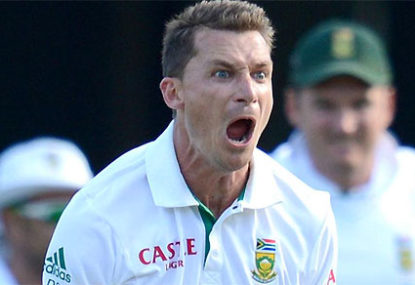If you think about it, bowling is largely about deception. The bowler uses all the tools at his disposal to press the batsman into error.
The aim is to prompt him into playing too early, too late, to misjudge the bounce or the pace, or to fail to properly adjust for the extent of the lateral movement.
While batting, there is a point beyond which the batsman is unable to make adjustments in order to connect with the ball.
He makes judgments based on information he is able to process before the ball arrives at that point; he will try to asses factors such as pace, probable bounce and deviation before deciding where and when to play.
He, therefore, has to predict the path the ball will travel and arrange to have it meet the middle of his bat at a certain time and place.
The introduction of helmets in the late 70s and improvements in body armour for batsmen has significantly reduced the intimidation factor that fast bowlers once traded in.
Where once they ran scared when the likes of Jeff Thomson, Michael Holding and Sylvester Clarke bore down on them, batsmen now stand their ground and even fight back, secure in the knowledge that life and limb is not so much at risk.
Not that high pace is ineffective; in favourable conditions, it is still a highly useful weapon in the pacer’s arsenal, but batsmen no longer surrender their wickets out of fear of the hard cricket ball, travelling at great velocity, coming into contact with relatively soft body.
Now that searing pace is no longer the terrifying prospect it once was, many bowlers have had to employ other talents in their quest to perform their duties well.
The very accurate bowler that is highly adept in all or a few of the other skills of the trade – seam, swing, change of pace, etc. – can forge a very good career in the fast bowling business even if he is not express.
South African fast bowler, Vernon Philander, to give just one example, has already collected 89 wickets in 16 Tests at a stingy average of 17.13 and an almost unheard of strike rate of 36. 84, despite operating at only medium pace.
Yet while it is possible for pacers to be effective without being particularly fast, it follows that the bowler who combines high skill with great pace will be even more lethal.
Such a bowler is Dale Steyn.
Sitting at the top of the Test rankings, the South African is currently the most feared bowler in the world.
Armed with the new ball, he delivers an outswinger that is more rapid than most and changes direction probably as late as any the game has seen.
When at the top of his game, surviving his opening spell is as much a matter of luck as it is of expertise, and the batsmen who fall victim to his wickedly late movement are often blameless; it is simply too much to expect even highly accomplished batsmen to make the kind of delayed adjustments that would be necessary to confidently combat the South African spearhead.
In January 2011, Indian batting genius Sachin Tendulkar compiled a highly acclaimed 146 against South Africa at Cape Town.
Steyn handed him a searching test of technique and temperament that the master batsman was able to overcome as he crafted what was voted the innings of the year by an esteemed panel of judges.
In two five-over spells – one in the morning and one after lunch on the third day – Tendulkar faced 48 of 60 deliveries and only survived because of his unmatched skills and some good fortune.
He was comprehensively beaten a number of times and might have been lucky to survive at least one of two appeals for caught behind. When Steyn found his edge, the ball went to ground, once flying through slips for four.
So substantial was the threat posed by the speedster that the 12 deliveries that Tendulkar didn’t face yielded two wickets – Cheshwar Pujara and MS Dhoni – and should have accounted for a third, but the ball that was deflected by Harbajahn Singh’s off-stump failed to remove a bail.
It can be strongly argued that the 29-year-old has been the most effective fastman in history.
Others, like Michael Holding and Jeff Thomson, have been faster and more hostile; others, like Malcolm Marshall and James Anderson, have been better fast bowling artists, parading a wider range of capabilities; but there has never been a pacer more likely to dismiss his opponent than Dale Steyn.
His strike rate of 41.1 is better than all bowlers with over 200 Test wickets.
To put that in perspective, it is useful to note that Marshall’s career strike rate is 46.7 – Dennis Lillee’s is 52. Also, Steyn’s 21 five-wicket hauls are only one behind Marshall’s 22, despite playing in 16 fewer Tests. His 332 wickets in 65 Tests – over five per game – at an average of 22.65 tells the tale of a bowler fit to be bracketed with the elites.
Cricket fans and pundits are notoriously nostalgic, and so the tendency to apportion accolades disproportionately to the champions of old is clear. Conditions were tougher then and players were better – at least as far as many of us are concerned.
Factors such as superior bats, flatter surfaces and shortened boundaries indicate that there were better times to be employed in the bowling business.
And in this age of higher batting averages and faster scoring rates, the claims of today’s bowlers should not be diminished.
It is time to accord Dale Steyn his rightful place at the top of the heap.






























































































